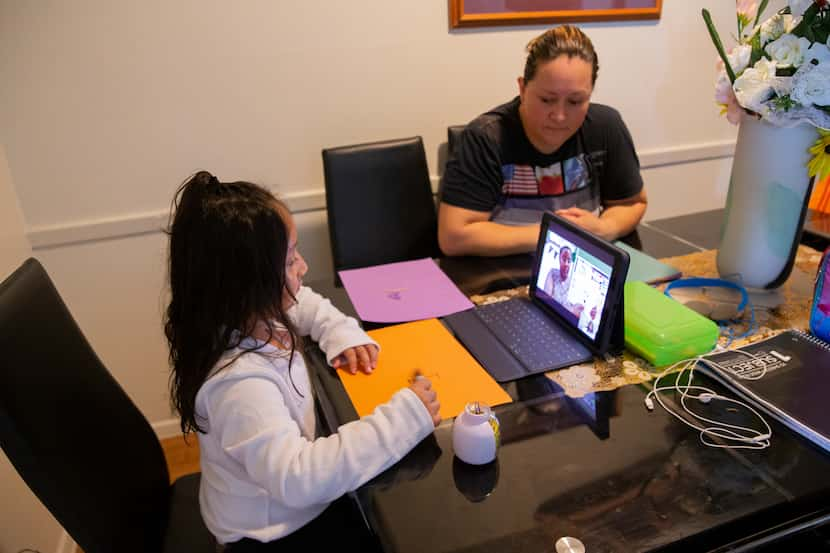When the coronavirus pandemic first reached Texas, school districts scrambled to launch virtual learning programs. Now, nearly a year-and-a-half later, districts are rushing to do so yet again.
A surge in COVID-19 cases driven by the delta variant and the lack of vaccine access for kids under 12 pushed several districts to offer last-minute online options — but not for everyone and not for long.
Dallas school leaders announced to eligible families on Thursday a short-term virtual option for children too young to get the COVID-19 vaccine and those who are medically fragile.
All DISD schools had reopened by Monday. Administrators hope this new option will appeal to the families who haven’t yet sent their kids back to the classroom for fear of the virus.
“It’s in the best interest of our students and the community that we get kids in school, even if it’s virtual and even if it’s unfunded,” deputy superintendent Susana Cordova said.
A last-minute walkout by the House Democrats during the regular session killed a Texas bill that would have funded virtual school similarly to in-person learning. That led many districts to backtrack their original plans to offer online programs.
Some districts are now reversing course as the pandemic drags on. It’s possible a similar funding bill could pass in the current special session, but that’s stymied by a lack of quorum.
Frisco, Plano, Coppell, Sunnyvale and Richardson ISDs also set up limited virtual programs, opening up enrollment days before their school years began. Garland announced plans late Wednesday, nearly two weeks after the start of classes in that district.
Only students in sixth grade or below — those too young to get the vaccine — are eligible to enroll. Most are only approved for the first nine weeks of fall, though they could be extended. This iteration of online learning also requires intensive commitments from parents in many cases, raising equity concerns.
While in-person learning is far more effective for the vast majority of students, families are fearful about returning to school amid a confusing patchwork of safety protocols. Gov. Greg Abbott issued an executive order banning school districts from mandating masks, which runs counter to Centers for Disease Control and Prevention recommendations.
Some local leaders are openly defying him and requiring face coverings in the classroom.
After Austin ISD announced it would require masks, KXAN reported, more than 750 parents re-enrolled their kids in in-person school after first signaling they wanted to do virtual learning.
Meanwhile, another Austin-area district announced that it filled all 350 available spots for its district’s virtual learning option within 19 minutes of the application process opening last week.
Frisco school officials didn’t set a limit on how many young students can enroll in its online program -- but that will cost them.
So far, more than 8,300 Frisco kids signed up -- more than 10% of their total student population. If they remain enrolled through the fall semester, administrators estimate they could lose roughly $30 million. For now, they plan to use much of their coronavirus relief aid to cover the cost, while holding out hope for state funding.
Dallas ISD superintendent Michael Hinojosa said virtual learning could cost his district $100 million this year, if 9,000 students took advantage of it for an entire academic year.
“That’s why we are starting nine weeks at a time, and then evaluating after that,” Hinojosa said. “But I’m sure we’ll have families choose to stay virtual for the second nine weeks.”
Changing minds
Even districts that were initially opposed to virtual learning are reconsidering. Prior to the school year, Highland Park ISD’s pandemic response committee discounted online classes.
“There’s strong, if not unanimous, very, very broad consensus among our teachers and our administrators that virtual instruction is inferior to in-person,” Board President Tom Sharpe said.
But since the committee last discussed the matter in June, COVID-19 cases rose. The district is now open to reconsidering, Superintendent Tom Trigg said during a Monday meeting.
Some have criticized districts for their reliance on families in this latest form of online learning, which could make the choice next to impossible for single and working parents.
In Plano ISD, the virtual program is “parent-led,” meaning it does not include live instruction and does not involve a campus teacher with a child’s daily work. Other districts, such as Garland, describe their offerings similarly.
“The temporary parent-led virtual learning plan is very different from what your child experienced last year during remote learning,” Garland officials wrote, noting all learning is self-paced and attendance won’t be taken. The district added that it’s relying on parents to run its virtual program because of a teacher shortage.
In Dallas, there will be teachers dedicated to the online learning program, with no classrooms that involve both virtual and in-person kids.
Roughly 2,400 students registered for Plano’s option as of Aug. 11, officials said, but that figure will likely fluctuate.
Offering virtual learning hasn’t been a clearcut decision.
Trustees in Hurst-Euless-Bedford ISD debated the issue at a two-hour meeting Monday before giving preliminary approval to offer a limited program for students in kindergarten through sixth grade. The board will vote again on the issue next Monday and if approved, the program wouldn’t start until Sept. 7 to allow the district time to hire and train staff.
Before the vote, substitute teacher Dianthe Hall urged trustees to reject the virtual learning proposal, saying “children have paid the price.”
“I currently have a classroom of extremely bright students, but the majority of them cannot legibly write their names,” Hall said. “They have been learning through screens instead of with pencil and paper.”
State officials have pointed to test results as evidence that virtual learning was not as effective as in-person instruction over the last year. STAAR results show greater learning loss in districts that had more students learning online for longer periods than in districts that had more students in face-to-face settings.
Brody Mulligan, a community member in HEB ISD, acknowledged that virtual learning is not without issues. But he stressed that trustees needed to recognize the medical concerns of some students.
“Providing a virtual option for the select students who have immunocompromised needs, who have specific medical needs, is the right thing to do,” Mulligan said. “It is the compassionate thing to do.”
In Fort Worth ISD, some trustees recently asked the administration to bring a virtual learning plan to the board for consideration. Trustee Daphne Brookins said such an option should be explored, citing the number of parents who are afraid to send their children to school.
She agreed in-person classes might be the best way for students to learn, but the board should do everything in its power to keep children safe.
“We want to make sure that they’re still learning,” Brookins said.
Some remote funding
The state has proposed at least one system under which Texas schools could still receive funding for remote learning, but it only applies to a limited number of students.
Quarantined students — those who have been identified as a close contact or have received a positive COVID-19 test — could keep up with classes through “remote conferencing,” a method of online learning approved by TEA, under the proposed rules.
Students in pre-K through fifth grade would have to receive at least four hours of instruction, two of which must be live with teachers each day. Older students would need at least four hours of live class for schools to get the funding.
Students only would be allowed to learn via “remote conferencing” for 20 class days, according to TEA’s proposal. And teachers couldn’t teach students in-person and remotely at the same time.
Districts have different policies for how they will handle students who are sick with COVID-19 or in quarantine.
Richardson ISD, for example, is hoping to rely on remote conferencing, which will be separate from its virtual learning option. Each elementary grade will have “COVID support teachers” who will Zoom with students while they are at home.
A COVID support teacher working with first graders, for example, will each day “check in with any of our first graders across the district who are in quarantine and provide direct math instruction and reading instruction,” deputy superintendent Tabitha Branum said. Other subjects will be covered by online activities and lessons.
“We will be evaluating and getting input from students, teachers and our parents, so that we can make any adjustments if needed,” she said.
Reporter Corbett Smith contributed to this article.
Stay connected to the latest in education by signing up for our weekly newsletter.
The DMN Education Lab deepens the coverage and conversation about urgent education issues critical to the future of North Texas.
The DMN Education Lab is a community-funded journalism initiative, with support from The Beck Group, Bobby and Lottye Lyle, Communities Foundation of Texas, The Dallas Foundation, Dallas Regional Chamber, Deedie Rose, The Meadows Foundation, Solutions Journalism Network, Southern Methodist University and Todd A. Williams Family Foundation. The Dallas Morning News retains full editorial control of the Education Lab’s journalism.




/cloudfront-us-east-1.images.arcpublishing.com/dmn/3PTVVLIGX5AHNA3N7PGQXEE7HI.png)
/cloudfront-us-east-1.images.arcpublishing.com/dmn/OIEZ4MD5QVFVDEY72QBGRG7D5Q.jpeg)
/cloudfront-us-east-1.images.arcpublishing.com/dmn/XQXAVNZZGEZG6XDK5GCBNZ2B4M.jpg)
:no_upscale()/cloudfront-us-east-1.images.arcpublishing.com/dmn/4QDVEJSJRRBTTP22M3JYUPGLRM.jpg)
/cloudfront-us-east-1.images.arcpublishing.com/dmn/GS3UVSU2EVC7XBGDJ5Q4FY5DIU.JPG)